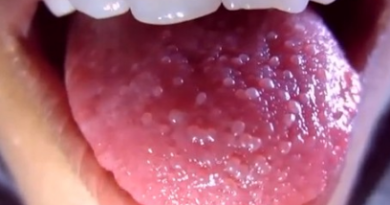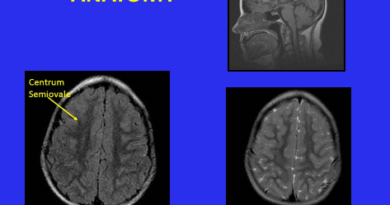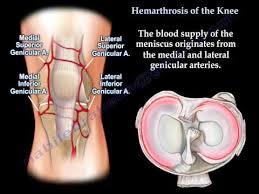Polycythemia Vera
What is Polycythemia Vera?
Polycythemia Vera is an idiopathic chronic and myeloproliferative disorder which has a very slow progression. It is characterized by an overproduction of the red blood cells from the bone marrow.
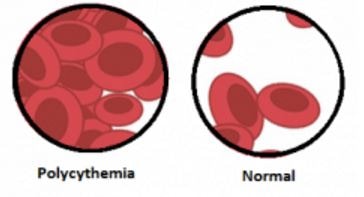
Red blood cells are responsible for carrying oxygen into blood cells to all body parts. Polycythemia Vera may also result in an overproduction of other blood cells, platelets and white blood cells as well. Due to an overproduction of blood cells, the blood will get thicker leading to various complications. [1]
Polycythemia Vera is not a common disease. It is usually diagnosed during a routine blood test examination as it tends to develop gradually over a long period of time without any signs or symptoms.
Without the necessary treatment, Polycythemia Vera is a serious medical condition, life –threatening as well. It also has the tendency of progressing to serious blood cancers like acute leukemia or myelofibrosis. [2]
Polycythemia Vera is more common among people over the age of 60 years old, even though it can affect people of any age. Rarely, Polycythemia Vera is diagnosed in people under the age of 40. Men are more affected then women. [3]
Signs and Symptoms
As mentioned, Polycythemia Vera is a disease with a slow progression which may cause no signs and symptoms at its early stages. However, many patients experience the following signs and symptoms: [4,5]
- Dizziness
- Headache
- Itchiness
- Excessive sweating
- Weakness
- Numbness
- A tingling or burning sensation in the hands, arms, feet or legs
- Painful swelling of the joints
- Breathing problems, especially when lying down
- Shortness of breath
- A feeling of fullness on the upper left part of the abdomen due to splenomegaly (increases spleen), etc.
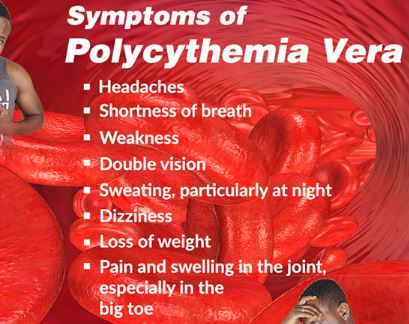
Less common signs and symptoms associated with Polycythemia Vera include:
- A tendency to bruise easily
- Hepatomegaly or liver enlargement
- Erythromelalgia
- Nosebleeds
- Bleedings from the gums, etc.

Causes of Polycythemia Vera
Polycythemia Vera results from an overproduction of red blood cells, as well as other blood cells from the bone marrow due to a mutation in a bone marrow cell.
In Polycythemia Vera the body’s mechanism which normally regulates the number of the each three blood cells does not function normally, resulting in an overproduction of one or more of the blood cells types.
A mutation of the gene JAK2V617F has been identified as the one causing Polycythemia Vera. However, other mutations have been identified as well in patients diagnosed with Polycythemia Vera, even though the role of these mutations is not yet known.
The real reason of the JAK2 protein mutation is not known. Researchers believe that the mutation occurs after conception, meaning that it is not an inherited mutation, rather an acquired one. The JAK2 gene is responsible for the production of a protein that helps make blood cells from the bone marrow. [6,7,8]
Polycythemia Vera Complications
Polycythemia Vera can lead to the following complications: [9]
- Splenomegaly
- Blood clots
- Skin problems
- Other blood disorders
- Other health problems due to an increased number of red blood cells, etc.
Splenomegaly or an enlarged spleen is one of the complications of Polycythemia Vera. The spleen will get larger than normally as it needs to work harder than normally due to the increased number of red blood cells.
Blood clots risk is increased due to the increased blood thickness, decreased blood flow and platelet abnormalities. If blood clots are created, there is a possibility of deep vein thrombosis, a heart attack, stroke, or pulmonary embolism.
Skin problems due to Polycythemia Vera are common. The skin may appear red, especially on the face often accompanied by itchiness, a burning or tingling sensation, especially after a warm bath or shower.
Other blood disorders like acute leukemia, myelofibrosis, or myelodysplasic syndrome are often associated with Polycythemia Vera due to a damage and disorder of the bone marrow.
Other health problems due to an increased number of red blood cells include gout, peptic ulcers, etc.
Diagnosis
Polycythemia Vera is diagnosed most frequently from a blood test examination. In a complete blood count (CBC) an increased number of red blood cells, elevated hematocrit measures, elevated levels of hemoglobin and very low levels of erythropoietin are revealed.
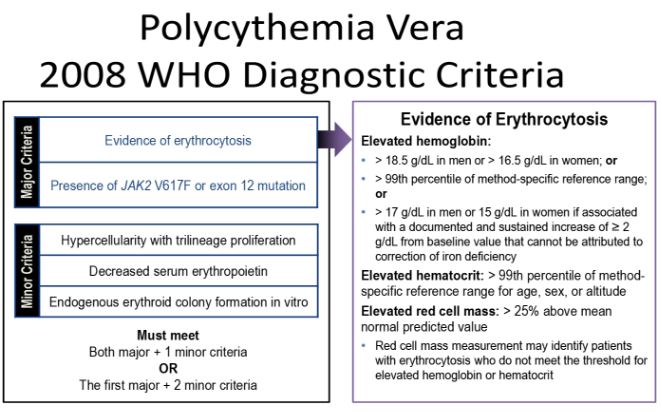
When Polycythemia Vera is suspected from a blood test, a bone marrow aspiration and biopsy are necessary. Usually a bone marrow aspiration and a biopsy of a solid bone marrow material are done at the same time. If examinations of the bone marrow show an increased production of the red blood cells, Polycythemia Vera is diagnosed.
A gene mutation test in cases of Polycythemia Vera will reveal a mutation in the cells JAK2 V617F.[10]
Treatment of Polycythemia Vera
There is no cure for Polycythemia Vera. As it is a chronic condition the treatment is only focused on reducing the amount of blood cells, which will help reduce the risk for various complications or eliminate and relief the signs and symptoms of Polycythemia Vera. [11,12]
Treatment of Polycythemia Vera includes:
Phlebotomy
It is a medical procedure which consists in taking out blood from the veins regularly. How often a phlebotomy will be necessary, depends from the severity of the condition.
Phlebotomy is used to reduce the circulating volume of red blood cells so that blood can circulate normally and function properly. Initially, 300 to 500 ml of blood is removed every other day. Once the hematocrit is below the targeted value, additional phlebotomies are performed as needed. In elderly patients 200 to 300 ml of blood is removed.
Aspirin
It is recommended to reduce the risk of blood clots. Low doses of Aspirin will also help relieve the burning sensation on the hands and feet.
- Antihistamines – are recommended to reduce and relieve itchiness.
- Ultraviolet light treatments – are also recommended to reduce and relieve itchiness and other skin problems.
- Medications to decrease blood cells such as hydroxyurea are recommended as well to suppress the ability of the bone marrow to produce red blood cells.
- Interferon alpha is also used to stimulate the immune system to fight the overproduction of the blood cells from the bone marrow.
Life Expectancy
With regular hematologist check – ups and treatment, people diagnosed with Polycythemia Vera haven been able to live for about 30 to 40 years, even longer. [13]
Prognosis
Polycythemia Vera is a rare type of blood cancer which has no cure. However, once diagnosed with Polycythemia Vera regular medical check – ups and treatment are necessary to reduce red blood cell production from the bone marrow, relieve the signs and symptoms as well as reduce the risk for possible complications.[14]
When first diagnosed with Polycythemia Vera, an appointment with a hematologist is necessary. Your hematologist will make an appointment schedule with you based on the progression of your disease. In general, it is recommended to see a hematologist about one a month or once in three months, always depending from your health condition and the progression of your disease.
If not diagnosed and treated regularly, Polycythemia Vera is a serious medical condition, even a life – threatening one due to its ability to progress in more serious forms of blood cancer like acute leukemia. Polycythemia Vera also increases the risk of heart attacks, stroke, or pulmonary embolism, which are, all life – threatening medical conditions.
The most common cause of death is thrombosis, followed by other complications like acute leukemia.
REFERENCES:
- Polycythemia Vera (February 2011) Available from: http://www.ncbi.nlm.nih.gov/pubmedhealth/PMH0001615/
- Mayo Clinic for Medical Education and Research. Polycythemia Vera. Available from: http://www.mayoclinic.com/health/polycythemia-vera/DS00919
- Polycythemia Vera Available from: http://en.wikipedia.org/wiki/Polycythemia_vera
- Polycythemia Vera Available from: http://rarediseases.org/rare-diseases/polycythemia-vera/
- Signs and Symptoms of Polycythemia Vera Available from: http://www.healthline.com/health/polycythemia-vera/sings-and-symptoms#1
- What causes Polycythemia Vera Available from: http://www.nhlbi.nih.gov/health/health-topics/topics/poly/causes
- Polycythemia Vera. Jakafi. Available from: http://www.jakafi.com/hcp/polycythemia-vera.aspx
- Polycythemia Vera Causes Available from: http://www.healthline.com/health/polycythemia-vera/causes-of-pv#Symptoms3
- Complications and Risks of Polycythemia Vera Available from: http://www.healthline.com/health/polycythemia-vera/complications-and-risks#1
- How is polycythemia vera diagnosed? Available from: http://www.nhlbi.nih.gov/health/health-topics/topics/poly/diagnosis
- How is polycythemia vera treated? Available from: http://www.nhlbi.nih.gov/health/health/topics/poly/treatment
- How I treat patients with polycythemia vera. Finazzi G. & Barbui T. Available from: http://www.bloodjournal.hematologylibrary.org/content/109/12/5104.long
- Polycythemia Vera: Prognosis and Life Expectancy Available from: http://www.healthline.com/health/polycythemia-vera/prognosis-and-life-expectancy#2
- Prognosis and treatment of polycythemia vera Available from: http://www.uptodate.com/contents/prognosis-and-treatment-of-polycythemia-vera

